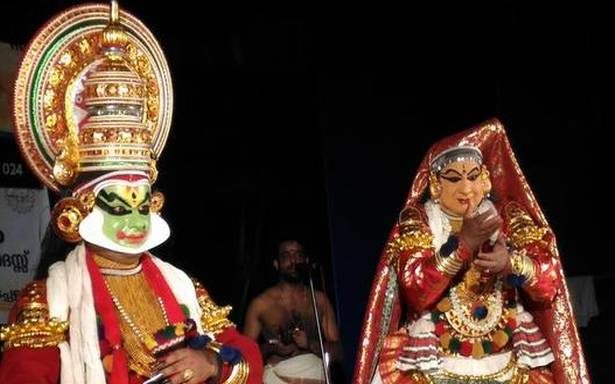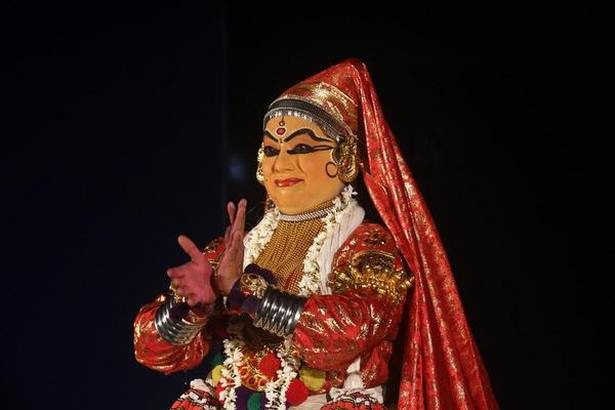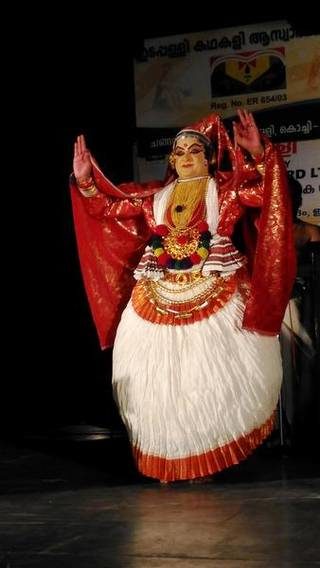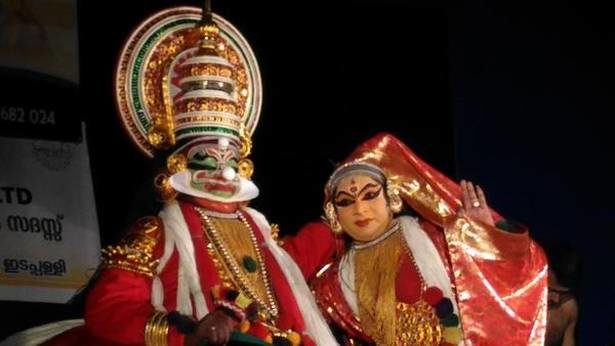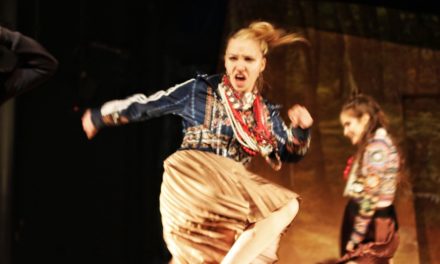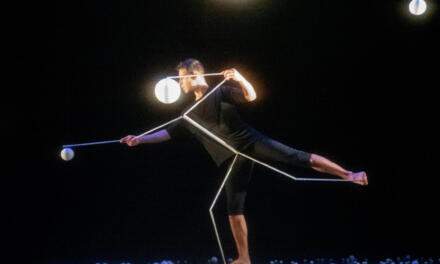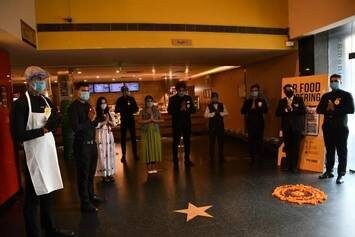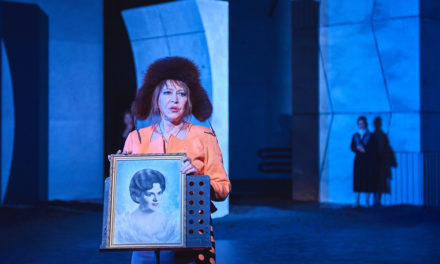Kamineeyakam Kathakali festival in Kochi offered a platform for artists to showcase their virtuosity and a chance for viewers to watch some of Kathakali’s finest in action.
‘Kamineeyakam,’ a five-day Kathakali festival at Changampuzha Park, Edappally, was a good attempt to familiarize new spectators with complex Kathakali plays.
The fête opened with Purappad and Melappadam, followed by Poothanamoksham, one of the most popular plays in Kathakali. While Kalamandalam Adithyan and Praveen performed all the four segments of the Purappad fluently, Kottakkal Madhu and Kalanilayam Rajeev sang the padams adhering to the kalapramaana (command over the tempos).
Madhu’s rendition of the charanam and navabhava of the Ashtapadi, ‘Manjuthara…’ in raga Vrindavanasarangam was a treat to the listeners. As the padam progressed to the charanam, ‘Chalamalaya,’ the vocalists began reveling in niravals and showcased many ragas. Sadanam Ramakrishnan, supported by Kalamandalam Hareesh, and Kalanilayam Manoj, assisted by Kalamandalam Hariharan, displayed their creativity on the chenda and the maddalam, respectively. Ramakrishnan’s forceful nerkol (vertical stroke of the stick at the center of the chenda) deserves special mention.
Poothanamoksham
Later, Kalamandalam Vijayakumar essayed Poothana evocatively. He depicted Poothana’s affection gradually being replaced by resentment towards child Krishna with admirable spontaneity.
Bakavadham
On the second day, Bakavadham was staged. Kalamandalam Shanmukhan’s Hidumbi disguised as Lalitha was an aesthetic treat as his ‘padardhabhinaya’ illuminated the sanchari (transitory) bhavas – curiosity, wonder, excitement, and angst – while anchoring on Sringara, the dominant rasa. Kottakkal Ravi’s strokes on the maddalam empowered the slow tempo kalasams executed by Shanmukhan.
As Bhima in the first scene, Kalamandalam Vipin was at his best. Kalamandalam Gopi took over the role of Bhima in the second scene when the marriage between Bhima and Hidumbi was solemnized. Gopi essayed the renowned sringara padam, ‘Baale Varika,’ with his characteristic adroitness. Seasoned vocalists Pathiyoor Sankarankutty and Kalamandalam Vinod sang the slow tempo padam corresponding to the visual semantics enacted by Gopi. Kalamandalam Unnikrishnan did not miss even a single beat as Gopi’s upangasoften turned to suggestive acting.
Kalamandalam Krishna Kumar effervescently performed the third and final segment of Bhima, who, on behalf of a poor Brahmin family, takes food to the abode of the demon, Baka. Kottakkal Devadas’ Baka thrilled the audience with his penetrating roars, impatience, and outbursts. Tinted with humor, his improvisations were impressive.
Kirmeeravadham
The third day’s festivities began with the entry of Simhika in Kirmeeravadham. Nelliyodu Vasudevan Namboodiri as Simihika was unusually brief in his Ilakiyattam, though he did full justice to the character. Kalamandalam Rajasekharan’s Lalitha in the second scene had a distinctive charm as his angika and satwikabhinayas for the padams, Nallarkulam and Kandaalathimodam had definite traits of the southern school of Kathakali. FACT Biju Bhaskar appeared as Panchali. For many among the audience, who had not seen the last excerpt of the play, Kalanilayam Vinod’s Kirmeera and Chinosh Balan’s Bhima were a refreshing experience. Kottakkal Narayanan accompanied by Vengeri Narayanan sang each and every padam with attention to diction and mood.
While Kalamandalam Sankara Warrier’s marvelous touches on the maddalam augmented the sringara rasa of Lalitha, Kalamandalam Raman Namboodiri’s expertise on the chenda enlivened the rest of the scenes.
Kalakeyavadham
The second half of the Kalakeyavadham play mainly hinges on a besotted Urvasi. With pathinja eratti in the eight-beat Chembada tala, Peesappilly Rajeev presented this challenging role convincingly. A celestial damsel adoring the handsome hero with carefully chosen metaphors, is uncommon to the visual dynamics of the Kathakali tradition. Rajeev succeeded in evoking the frustration and sorrow of Urvashi closely ahead of cursing Arjuna. Kalamandalam Ramachandran Unnithan as Kalakeya was both authoritative and succinct. The musical rendition of Kalamandalam Babu Namboodiri, Vinod and Vishnu was a blend of classicism and melody. Percussionists Kottakkal Prasad, Kalamandalam Ravisankar, Kalamandalam Prakasan and Srikumar suppported each character appropriately on the chenda and the maddalam, respectively.
Narakasuravadham
On the final day, the play Narakasuravadham was presented in front of a packed audience. Kalamandalam Hari R. Nair performed Nakrathundi with fascinating theatrical tones.
While his expression of intense yearning for a dalliance with Jayantha, the son of Lord Indra, was all too vivid, he did not go in for the therupparakkal, an essential ingredient of any female demon in Kathakali. Margi Vijayakumar, the seasoned actor of leading female roles, presented the Sari and the slow tempo padam soaked in rathibhava. Nedumbally Rammohan and Sadanam Jyothish Babu eloquently sang the slokams and the padams. Rammohan’s rendition of the charanam, ‘Prananadhan…’ in raga Lalitha, was befitting to the contextual mood. Kalamandalam Vysakh in the role of Jayantha was both charming and articulate. As he chopped off the breast and the nose of Nakrathundi, the scene was set for the dramatic appearance of Ninam (the mutilated Nakrathundi appearing before Narakasura with blood all over the body).
Sadanam Krishnankutty’s Narakasura was immaculate. Kalamandalam Balasundaran and Srihari traced the expressions meticulously on the chenda. Kalamandalam Achutha Warrier and Venu provided excellent support on the maddalam.
This article was originally published in The Hindu. Reposted with permission. Read the original article.
This post was written by the author in their personal capacity.The opinions expressed in this article are the author’s own and do not reflect the view of The Theatre Times, their staff or collaborators.
This post was written by V. Kaladharan.
The views expressed here belong to the author and do not necessarily reflect our views and opinions.

